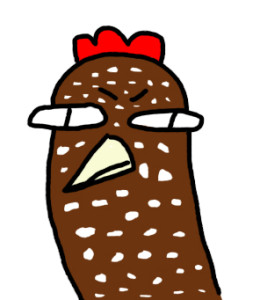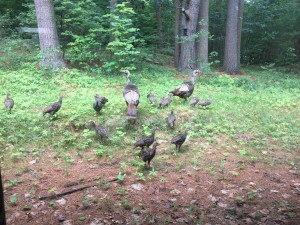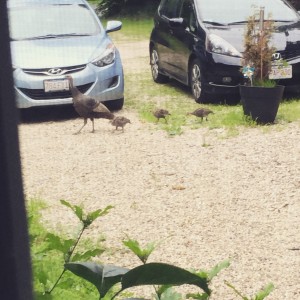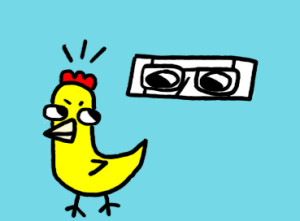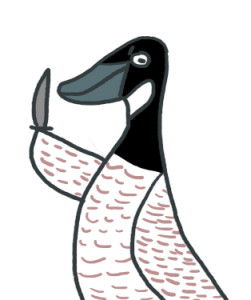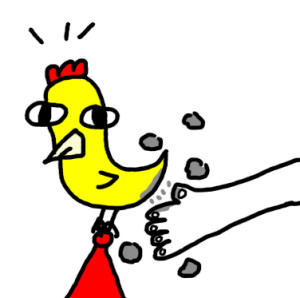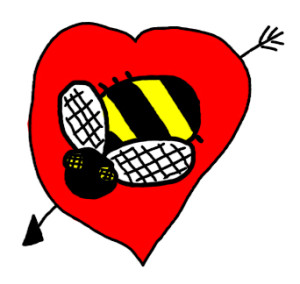Butt Update
September 11th, 2015There are exciting things going on in the land of butts, so I thought I’d give everyone a butt update. I was going to shorten that and call it a “buttdate,” but then it occurred to me that that might mean different things to different people, and so it remains “butt update.” Not to worry, this is an update about animal butts, mostly chickens, so hopefully it won’t venture into TMI territory.
The big news is that butt feathers are very much making a comeback, much like skinny jeans and 90s music. I would say that butt feathers serve a more noble purpose than those other things, but I suppose pants are important, regardless of the style, so I’ll let that one rest. However, upon last night’s butt check, I saw how much progress we’ve made on the feather front. Suzy Creamcheese Junior’s butt is looking like a little porcupine with all the feather buds sticking out of it. That’s a great sign. The feathers are moving right along, and soon her bald spot will be gone, so we won’t need to consider a feathery comb-over anymore. On the down side, her chest seems to be looking ratty, and I’m not sure if that’s mite related, or if she’s molting. It’s looked this way all summer, so I think it may be at least part mites, but I’m not entirely sure. I’m going to keep hitting it with some diatomaceous earth once a week until it starts to look better, just to be safe. If it is mites, I don’t want them to move back down to her butt and undo all the progress there.
Since SCJ was looking so good, I also went and checked Henny Penny, since she was the first chicken to experience the loss down below. She’s making progress, but not as much as Suzy, but I guess she also has a longer road to travel back to wellness. The little nubs of feathers are becoming more plentiful, but she hasn’t reached the porcupine/pincushion stage that Suzy has. I checked the remaining butts, and everyone seemed to be sprouting new growth, so this is all promising. The others had pretty mild infestations, so they don’t have nearly as many feathers to grow back. I will definitely remain vigilant, since I now know just how bad mites can be, and how long a road back to wellness it is.
I also had a run-in with a different animal butt this week. Remember the cat that scared me in the dark and is stalking one of our cats? Well, I ran into him/her in the daylight the other day, so it wasn’t nearly as frightening. He/she is actually quite a pretty cat, however, at the time we met, he/she was in the process of using some of the leaf litter at the edge of our yard as a litterbox. I suppose pretty much all the animals around here do, so it’s not worth getting worked up over. I decided that I wanted to pet this mystery cat in the hopes of us becoming friends, so there are no more surprises in the dark. I waited for him/her to finish his/her business, and then I made my slow approach. I got very close, and that’s when it turned out that he/she wasn’t done. #1 had been taken care of, but #2 still needed dealing with. And as #2 got dealt with, it became clear that this cat might not be feeling so well. I imagine outdoor cats can eat any number of things that can give them parasites or make them sick, but it got me wondering if this cat even has a home. This isn’t the best area to let your cat outside in due to predators (and this isn’t even addressing the issue of outside cats generally being a bad idea anyway). If he/she has survived so long, is that because he/she has a home, or because he/she has very good survival instincts? He/she is fairly slight, and clearly sick, so I have no way of knowing. No collar was present, but that doesn’t necessarily mean anything. I managed to get close enough to get in a quick pat, and then he/she decided to take off, leaving me wondering if we need to try to catch him/her and get the vet involved. I suppose we could then see if the cat is microchipped and belongs to anyone. I’m not sure how easy it will be to catch him/her, or if it’s even my business. I just hate seeing animals that don’t seem to be well cared for, and this one has some of the hallmarks. Then, if he/she has no owner, the bigger question becomes: do we need another cat? Do we even have room for one? How do we even catch a possibly wild cat? Too many questions, too many chickens, too many kitties?
(CREDITS: Theme music: Chicken In The Barnyard by Fireproof Babies, Music bed: Shake It and Break It by Lanin’s Southern Serenaders)










